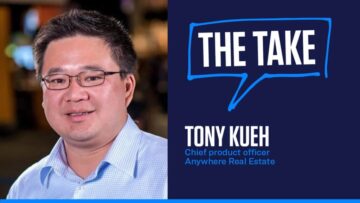
In these times, it’s time to double down — on your skills, on your knowledge — on you. Join us Aug. 8-10 at Inman Connect Las Vegas to lean into the shift and learn from the best. Get your ticket now for the best price.
In 2021, a round of Series D financing landed HomeLight in “unicorn” status, a painfully clichéd bit of tech-speak coined in Silicon Valley bro-tanks to describe a company worth a billion dollars.
That valuation is likely a frequent topic of conversation at Clever Real Estate, a company executing a very similar model, different in only how the leads are obtained.
Clever’s Tony Cahal said in a call with Inman that it has 18,000 agents in its nationwide network, and its website publishes that more than 20,000 sales have originated with its service.
“Typical online leads close about three to seven percent of the time, ours close at 13 to 17 percent,” Cahal said.
Clever Real Estate finds its leads with extensive content marketing, reams of articles on its website designed to educate consumers on a vast range of real estate topics. The company uses calls-to-action, published research and other tactics to vet potentially actionable buyers and sellers, and only begins the matching process when a user explicitly states they’re ready to speak to an agent.
An in-house team further vets the person and gathers basic details, such as budget, location, wants, needs and the other items essential to being defined as a quality lead.
Leads that surface in an area with competing agents registered with Clever will be sent to the agent that ranks higher according to the company’s performance evaluation. There’s a timed response mechanism for claiming leads too.
HomeLight, a consumer-to-agent matching platform, uses advertising on national television to collect leads for real estate agents.
Its mantra is that consumers can save money and work with “top” agents. The last part is hard to prove, but the first, not so much.
The method is simple: Because the company sends agents a lot of business, they’ll work for less. It’s a mere numbers game. The agent then pays HomeLight for those lead acquisition costs at closing. There’s nothing nefarious or untoward about it, it’s simply sleight-of-hand referral marketing.
Along with charging agents 33 percent for the referral — after 10 years at 25 percent — the platform also offers a variety of services, including HomeLight Trade-In and HomeLight Cash Offer. Zillow (35 percent) and OpCity (30 to 40 percent) charge, on average, more than HomeLight.
Not everyone is on board with Clever and HomeLight’s business model. Inman spoke with HomeOpenly founder Dmitry Shkipin in 2022, who is in a lawsuit with HomeLight that alleges the referral model is merely cloaking for kickbacks.
Shkipin’s company uses transparent competition between member agents as a method of saving consumers money.
“Our revenue is generated with optional ads from real estate verticals due to the added value of network effects,” according to its website.
Regardless of how these companies aim to help the consumer save money, it might very well be a fruitless endeavor to begin with, because no one has really asked the consumer if saving money on a home purchase or sale is important to them, at least when juxtaposed with other benefits. This was the topic of a talk given at Inman Connect New York last month.
The CEO of marketing company 1000Watt, Brian Boreo, shared an extensive, 1000-person survey of millennials that revealed, above all else, consumers want an easier transaction and that saving money isn’t as critical as many presume.
“Commissions over the last 30 years have declined by 15 percent, not trivial,” he said. “But, over half of that decline took place before 2000, before the launch of Redfin, before the launch of scary Zillow, before the launch of moon-shooting Opendoor.”
Fifty percent of 1000watt’s survey respondents said they would take a cash offer for less money if it came with a quick process and the dependability of closing on time.
What people want, Boero said, is less stress during the transaction, not pitches about commission costs.
“When we look at people who bought in the last three years, 36 percent said their agent didn’t even find it necessary to explain how they were compensated,” he said. “The stats also showed that 10 percent had no idea how their agent was compensated. It’s not a hot-button topic.”
Clever’s content education model is certainly worthwhile. The more informed a buyer or seller is before engaging their agent, the less suffering the agent endures. After all, time kills deals. The quicker decisions can be made, the higher likelihood a deed will get recorded.
Keeping Current Matters uses content marketing to help agents win business too. However, it doesn’t facilitate the lead engagement or charge referral fees, instead using a content subscription model, allowing agents to leverage what they pay for however they see fit. KCM charges for the content, not the lead.
Cahal, who helped HomeLight excel in the space, said Clever is currently measuring about 10 million annual visitors. It has plans to build out an extensive agent portal that will measure leads and assist in lead communications, among other features.
Some leads come over time with patient branding, learning your market and creative outreach. Others come by wearing a name tag to your child’s dance recital.
But agents need to understand that however they earn their keep in the industry, by one way or another, they’re paying for leads.
- SEO Powered Content & PR Distribution. Get Amplified Today.
- Platoblockchain. Web3 Metaverse Intelligence. Knowledge Amplified. Access Here.
- Source: https://www.inman.com/2023/02/10/clever-offers-its-own-take-on-the-lead-referral-model/
- $10 million
- 000
- 10
- 2021
- 2022
- 35 percent
- a
- About
- about IT
- above
- According
- acquisition
- added
- Ads
- Advertising
- After
- Agent
- agents
- All
- alleges
- Allowing
- among
- and
- annual
- Another
- AREA
- articles
- assist
- Aug
- average
- basic
- because
- before
- being
- benefits
- BEST
- between
- Billion
- Bit
- board
- bought
- branding
- Brian
- budget
- build
- business
- business model
- buyers
- call
- Cash
- ceo
- certainly
- charge
- charges
- charging
- Close
- closing
- coined
- collect
- COM
- come
- commission
- Communications
- Companies
- company
- Company’s
- compensated
- competing
- competition
- Connect
- consumer
- Consumers
- content
- content marketing
- Conversation
- Costs
- Craig
- Creative
- critical
- Current
- Currently
- dance
- Deals
- decisions
- Decline
- defined
- describe
- designed
- details
- different
- Doesn’t
- dollars
- double
- down
- during
- earn
- easier
- educate
- Education
- effects
- engagement
- engaging
- essential
- estate
- evaluation
- Even
- everyone
- Excel
- executing
- Explain
- extensive
- facilitate
- Features
- Fees
- Find
- finds
- First
- fit
- founder
- frequent
- from
- further
- game
- generated
- get
- given
- Half
- Hard
- help
- helped
- higher
- Home
- How
- However
- HTML
- HTTPS
- idea
- important
- in
- Including
- industry
- informed
- instead
- IT
- items
- join
- Join us
- Keep
- Kills
- knowledge
- Las Vegas
- Last
- launch
- lawsuit
- lead
- Leads
- LEARN
- learning
- Leverage
- likely
- location
- Look
- Lot
- made
- Mantra
- many
- Market
- Marketing
- matching
- measure
- measuring
- mechanism
- member
- merely
- method
- might
- Millennials
- million
- model
- money
- Month
- more
- name
- National
- national television
- Nationwide
- necessary
- Need
- needs
- network
- New
- New York
- numbers
- obtained
- offer
- Offers
- ONE
- online
- originated
- Other
- Others
- outreach
- own
- part
- patient
- Pay
- paying
- pays
- People
- percent
- performance
- person
- pitches
- Place
- plans
- platform
- plato
- Plato Data Intelligence
- PlatoData
- Portal
- potentially
- price
- process
- Prove
- published
- Published research
- Publishes
- purchase
- quality
- Quick
- quicker
- range
- ranks
- ready
- real
- real estate
- recorded
- Referral
- registered
- research
- response
- Revealed
- revenue
- Said
- sale
- sales
- Save
- saving
- Sellers
- Series
- service
- Services
- seven
- shift
- Silicon
- Silicon Valley
- similar
- Simple
- simply
- skills
- So
- Space
- speak
- States
- stats
- Status
- stress
- subscription
- Subscription model
- such
- suffering
- Surface
- Survey
- tactics
- TAG
- Take
- Talk
- team
- television
- The
- their
- three
- ticket
- time
- Timed
- times
- to
- Tony
- too
- topic
- Topics
- trade-in
- transaction
- transparent
- understand
- us
- User
- Valley
- Valuation
- value
- variety
- Vast
- VEGAS
- verticals
- VET
- visitors
- Website
- What
- WHO
- will
- win
- Work
- worth
- worthwhile
- would
- years
- Your
- zephyrnet
- Zillow












